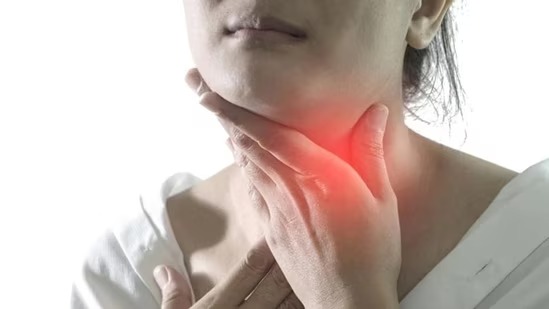Effects of hyperthyroidism on skin health: Signs and precautions to take if you have thyroid issues
Hyperthyroidism, also known as an overactive thyroid, is characterized by the thyroid gland producing too many thyroid hormones. These hormones are important for controlling many body processes and affect almost all major organs. Notably, hyperthyroidism also affects the skin because too many thyroid hormones speed up body processes. Increased blood flow, metabolic rate, and cell proliferation are signs of this increased activity, and these factors take together to have a major impact on skin health.

Given the complex relationship that exists between hyperthyroidism and skin health, it is essential to investigate the symptoms and implement practical measures to protect the skin from the effects of this thyroid condition.
Knowing How Hyperthyroidism Affects Skin Health
Dr. Shweta Shetkar, MBBS, DDV, dermatologist and cosmetologist at Amaryllis Skincare Clinic in Mumbai, discussed the profound effects of hyperthyroidism on the skin in an interview with HT Lifestyle. She explained that the accelerated growth of skin cells can cause a variety of issues and that hyperthyroidism differs from hypothyroidism in that it causes unique skin problems. –
1. Skin Rash: A frequent sign of hyperthyroidism, a rash usually appears in skin creases.
2. Hives (Urticaria): Hyperthyroidism may cause painless, elevated skin patches that are often accompanied by itching.
3. Itchiness: Whether or not there are rashes or hives, itching feelings may appear.
4. Skin discoloration: Affected regions may show signs of discoloration along with a distinct texture that is rigid and waxy.
5. Unusual Warmth: Skin that is warm and perspires might be caused by hyperthyroidism’s elevated metabolic rate, which also increases heat sensitivity.
She emphasized, “The main cause of hyperthyroidism is Graves’ disease, which often coexists with pretibial myxedema. Known as Graves’ dermopathy, this secondary skin ailment often coexists with eye bulging and swollen fingers. It presents as lumpy and inflammatory skin on the lower thighs. For people with hyperthyroidism to get thorough therapy and care, it is essential to comprehend these skin symptoms.
Recognizing the Features of a Hyperthyroid Rash
Dr. Shweta Shetkar states that individual characteristics, such as skin tone, might affect how a hyperthyroid rash looks and feels. “The rash may appear in shades of purple, red, or brown and may be accompanied by the development of raised patches known as hives,” she said in her explanation. Itching and soreness are common characteristics of a hyperthyroid rash. The afflicted skin may be heated, and people may be more sensitive to heat, which might result in perspiration.
She went on, saying that in addition to face flushing, there may also be redness and perspiration in the palms of the hands and soles of the feet. In addition to the rash, people with hyperthyroidism may have skin and hair thinning. It is crucial to acknowledge these unique characteristics in order to precisely identify and effectively treat skin-related symptoms linked to hyperthyroidism.
Handling and Curing Skin Conditions Resulting from Hyperthyroidism
“Treating skin issues related to hyperthyroidism requires a comprehensive approach that includes both targeted treatment strategies and symptom relief,” said Dr. Shweta Shetkar. Topical lotions and ointments may help with symptoms like itching, but it’s important to realize that they just relieve the symptoms momentarily and don’t deal with the underlying cause of the rash. The selection of a course of therapy for skin issues associated with hyperthyroidism is contingent upon a number of criteria, such as age, underlying medical disorders, severity of the ailment, and possible pharmaceutical allergies. According to her, a medical expert could advise –
Medication: Antithyroid drugs like methimazole may decrease the synthesis of thyroid hormones, while beta-blockers might help with symptoms like anxiety and a fast pulse.
Radioactive iodine is used in radioiodine therapy, which usually requires many treatments to completely eliminate the thyroid tissue that produces hormones.
Surgery: To reduce the production of thyroid hormones, a surgeon may choose in some situations to remove a portion of the thyroid.
Furthermore, according to Dr. Shweta Shetkar, the following short-term treatments that directly address skin issues may be prescribed:
Topical steroids: Used to reduce inflammation in cases of rashes.
Steroid Injections: Given to reduce inflammation that causes rashes.
Antihistamines: Used topically or orally to relieve itching.
Botox injections, also known as botulinum toxin, are used to reduce excessive perspiration.
A healthcare provider will design a customized treatment plan after carefully evaluating each patient’s unique health circumstances and hyperthyroidism symptoms.
Recognizing When to Get Medical Help
“It is advisable to consult a healthcare professional if there are indications of hyperthyroidism, especially when accompanied by skin rashes,” said Dr. Shweta Shetkar. Blood tests are usually performed by a physician to measure thyroid hormone levels, which may help determine if the thyroid gland is hyperactive. You should get medical help right away if –
Rash or Hives: It’s critical to get medical attention right away if you develop rashes or hives that appear out of the blue and spread quickly.
Extra Symptoms: If skin problems are accompanied by other worrisome symptoms like breathing difficulties, fever, or discharge, get in touch with a doctor every once. These can indicate a more serious underlying issue that needs to be treated right away.
Early detection and treatment of skin issues associated with hyperthyroidism will help ensure effective management of any consequences.







